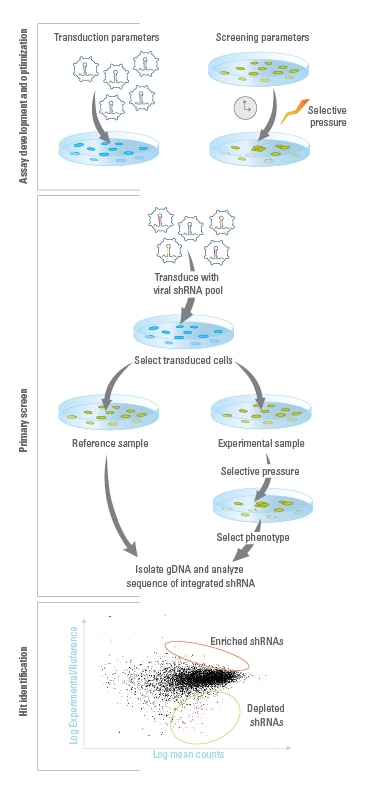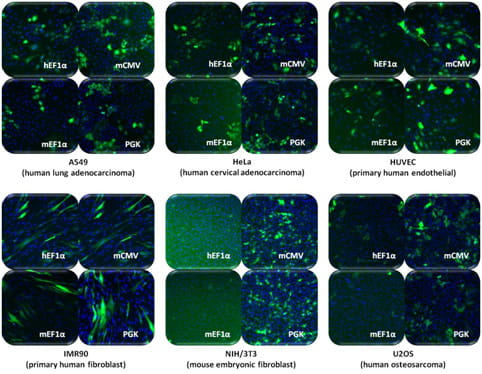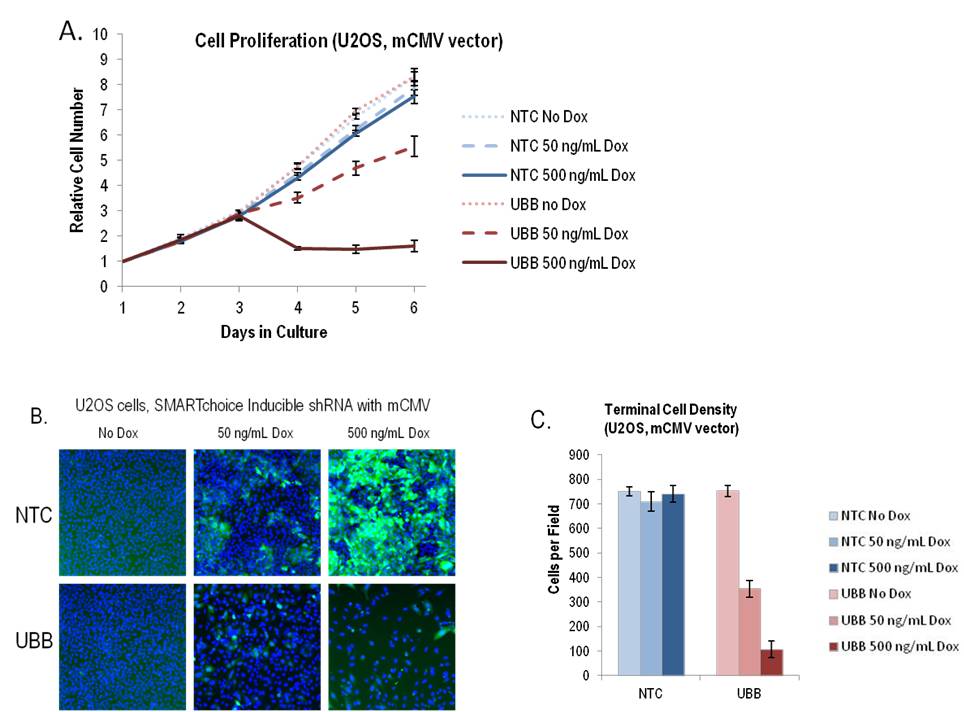- Dharmacon Screening libraries
- SMARTvector Inducible Lentiviral shRNA Pooled Libraries
SMARTvector Inducible Lentiviral shRNA Pooled Libraries
Inducible shRNA expression for regulatable and controlled functional analysis screens

Optimal shRNA expression for high-confidence functional analysis results
Our most advanced shRNA platform, SMARTvector inducible lentiviral shRNAs utilize the flexibility of promoter and reporter options and the tight regulation of expression from the Tet-On® 3G transactivator protein coupled with our most advanced rational design algorithm to target the complete genome for human, mouse, and rat protein-coding and long non-coding genes.
Pooled lentiviral libraries offer an efficient and cost-effective method for screening large numbers of genes without automation. Library construction, pooling techniques, and high-throughput sequencing-compatible screening workflows have been experimentally validated to ensure reproducibility and accurate hit identification. Learn about optimal library design and the pooled screening workflow on our Pooled lentiviral screening libraries page.
Highlights:
- Innovative vector design for robust inducible shRNA expression from SMARTvector inducible lentiviral shRNA
- SMARTchoice configuration options give you a choice of four promoters and two fluorescent reporters for optimal performance in your experiment
- Tightly controlled regulation of shRNA expression from the Tet-On® 3G transactivator protein
Choose SMARTvector lentiviral shRNA pooled libraries for constitutive shRNA expression.
Each SMARTvector inducible lentiviral shRNA is made up of pools containing:
- ≥ 5 x 107 TU/mL (+/- 20 %) lentiviral particles provided in pre-aliquoted tubes
- 8 x 25 µL (200 µL total) for pools ≤ 5000 constructs
- 16 x 25 µL (400 µL total) for pools > 5000 constructs
- 100 Non-targeting control constructs
- 272 constructs targeting 34 human or mouse protein coding genes as gene-specific controls (8 shRNA per gene); includes common reference genes (PPIB, GAPD, Actin, Lamin) and viability-related genes.
- A data file including construct sequences, target gene IDs, and counts per millions of mapped reads
SMARTvector inducible lentiviral shRNA libraries are available for defined sub-libraries of gene families up to the entire genome for human and mouse; rat libraries and custom SMARTvector inducible lentiviral shRNA collections are available upon request.
- Request a custom collection of human or mouse gene-targeting shRNAs
- Pools are provided as purified, concentrated lentiviral particles
- ≥ 5 x 108 TU/mL for constitutive vectors and ≥ 5 x 107 TU/mL for inducible vectors
Request pricing for a custom pooled library
Before ordering, download these invaluable tools to carefully plan your pooled lentiviral shRNA screen and calculate the amounts of components required:
- SMARTvector & shMIMIC lentiviral pooled libraries technical manual
- Pooled lentiviral screening laboratory protocols & Calculation tracking worksheet
Reagents recommended in our validated protocol:
- Vector-matched SMARTvector Inducible Non-targeting control for transduction optimization
- SMARTvector Indexing PCR and Sequencing Primer Kits (A & B) with 12 unique indexing primers, optimized and experimentally validated for:
- Efficient PCR amplification of genomic DNA with minimal bias
- High-throughput multiplexed Next Gen Sequencing for hit identification
SMARTvector Lentiviral shRNA pooled library coverage*:
| Collection | Human | Mouse | ||
|---|---|---|---|---|
| # targeted genes | Number pools and average shRNA per pool | # targeted genes | Number pools and average shRNA per pool | |
| Genome | 19241 | 16 pools of 9513 shRNA | 21745 | 18 pools of 9502 shRNA |
| Druggable genome | 7341 | 6 pools of 9735 shRNA | 9723 | 8 pools of 9670 shRNA |
| GPCR | 377 | 1 pool of 3012 shRNA | 494 | 1 pool of 3909 shRNA |
| Ion Channel | 340 | 1 pool of 2709 shRNA | 332 | 1 pool of 2646 shRNA |
| Phosphatase | 245 | 1 pool of 1948 shRNA | 268 | 1 pool of 2141 shRNA |
| Protease | 466 | 1 pool of 3702 shRNA | 529 | 1 pool of 4206 shRNA |
| Protein kinase | 702 | 1 pool of 5602 shRNA | 697 | 1 pool of 5558 shRNA |
| Ubiquitin conjugation | 557 | 1 pool of 4431 shRNA | 511 | 1 pool of 4069 shRNA |
| Apoptosis | ** | |||
| Cell cycle regulation | ** | |||
| De-ubiquitinating enzymes | ** | |||
| Membrane trafficking | ** | |||
| DNA damage response | ** | |||
| Epigenetics | ** | |||
| Nuclear receptor | ** | |||
| Transcription factors | ** | |||
Important Notice
The Products are solely for internal research use (as set forth in the Product Terms and Conditions) in laboratories where the containment measures stated below and in applicable laws and regulations are met. Products may not be used for diagnostic, therapeutic or other commercial purposes and may not to be administered to humans for any purpose or to animals for therapeutic purposes. The Products are replication-incompetent, self-inactivating (SIN) and non-pathogenic (do not cause infectious human disease).
Any investigator who purchases lentiviral particle products is responsible for consulting with their institution’s health and biosafety personnel for specific guidelines on the handling of lentiviral vector particles. Furthermore, each investigator is fully responsible for obtaining the required permissions for research use and the acceptance of replication-incompetent SIN lentiviral vectors and replication-defective lentiviral particles into their local jurisdiction and institution.
Elements of the SMARTvector Inducible shRNA Lentiviral Backbone

| Vector Element | Utility |
|---|---|
| 5' LTR | 5' Long Terminal Repeat necessary for lentiviral particle production and integration of the construct into the host cell genome |
| Ψ | Psi packaging sequence allows viral genome packaging using lentiviral packaging systems |
| PTRE3G | Inducible promoter with Tetracycline Response Element is activated by the Tet-On® 3G protein in the presence of doxycycline |
| tGFP or tRFP | TurboGFP or TurboRFP reporter for visual tracking expression upon doxycycline induction |
| SMARTvector universal scaffold | Optimized proprietary scaffold based on native primary microRNA in which gene-targeting sequence is embedded |
| PuroR | Puromycin resistance permits antibiotic selection of transduced cells |
| 2a | Self-cleaving peptide enables the expression of both PuroR and Tet-On® 3G transactivator from a single RNA pol II promoter |
| Tet-On® 3G | Encodes the doxycycline-regulated transactivator protein, which binds to PTRE3G promoter only in the presence of doxycycline |
| WPRE | Woodchuck Hepatitis Post-transcriptional Regulatory Element enhances transgene expression in target cells |
| 3' SIN LTR | 3' Self-inactivating Long Terminal Repeat for generation of replication-incompetent lentiviral particles |
An Optimized Inducible Gene Silencing System in a Single Vector

The SMARTvector Inducible Lentiviral shRNA vectors incorporate the Tet-On® 3G bipartite induction system a 3rd-generation Tet-inducible system significantly improved and optimized for minimal basal expression (lowest leakiness) and potent activation upon induction (Zhou X, et al., Gene Therapy 13, 1382 (2006) and Loew R, et al., BMC Biotechnol. 10, 81 (2010)). The Tet-On® 3G Inducible System permits tightly controlled shRNA expression and study of gene function in vivo and in vitro with unprecedented precision.
Pooled SMARTvector Screening Workflow

Assay Development and Optimization: Establish optimal experimental conditions, including those for a) lentiviral transduction and b) screening parameters, such as selective pressure and time between collection of reference and experimental samples.Primary Screen: A stable population of cells expressing single integrands of constructs are created by transducing lentiviral pools at low MOIs. Transduced cells are then split into reference and experimental populations for application of a selective pressure that induces the phenotype of interest. Genomic DNA (gDNA) is then isolated from reference and experimental populations of transduced cells. Illumina-adapted primers and Phusion Hot-Start II High Fidelity DNA Polymerase are used to PCR amplify integrated construct sequences and add Illumina flow-cell binding sequences. The resulting amplicons are run on Illumina platform sequencers, using the sequencing primers provided.Hit Identification and Follow-up: Construct sequences are identified in reference and experimental libraries. Constructs that are enriched or depleted during the screen are identified as hits, and the genes that they target are identified. Hits can be confirmed and studied further using individual constructs that can be ordered from the Dharmacon catalog collection.
SMARTvector Inducible Lentiviral shRNA promoter activities differ across cell types

SMARTvector Inducible Lentiviral shRNA Non-targeting Controls were used to transduce the indicated cell types at MOI = 0.3. 24 h after transduction, expression of the non-targeting shRNA and PuroR was induced with 1 µg/mL doxycycline. After 48 h of culture in the presence of doxycycline, cells were stained with Hoescht-33342 and nuclei (blue) and TurboGFP (green) were imaged. While ~30% of the cells in the field have been transduced, some images may appear to contain fewer than 30% TurboGFP-positive cells due to low TurboGFP expression, indicative of low constitutive promoter activity, in a particular cell type.
SMARTvector Inducible Lentiviral shRNAs permit tunable knockdown of specific target genes in human primary cells with all four promoter options.

HUVEC (primary human umbilical vein endothelial) cells were transduced at MOI = 0.2 with the indicated SMARTvector Inducible Lentiviral shRNA vectors carrying a non-targeting control shRNA (NTC) or shRNAs directed against RHOA or GAPDH. Cells were selected with 1.5 µg/mL puromycin for 72 hours. shRNA expression was then induced with 0, 0.01, 0.1, 1.0 and 10 µg/mL doxycycline, respectively, and mRNA was harvested 72 hours after dox-induction. Target gene silencing was measured by RT-qPCR relative to the PPIB reference gene. Gene silencing is expressed relative to the vector- and doxycycline dosage-matched NTC cell population.
SMARTvector Inducible Lentiviral shRNAs enable tightly controlled knockdown of essential genes in a time- and doxycycline dose-dependent manner

U2OS cells were transduced at MOI = 0.1 with SMARTvector Inducible Lentiviral mCMV vectors carrying either a non-targeting control shRNA (NTC) or an shRNA directed against the ubiquitin B (UBB) gene. Cells were selected for 3 days with 1.5 µg/mL puromycin. After selection, cells were seeded at 2000 cells per/well in 96-well plates. 24 hours later (Day 1), shRNA expression was induced with the indicated dose of doxycycline, and cell number was then measured each day with the Cell Titer-Glo® assay (Promega). Each data point represents the mean and standard deviation of six independent wells. B. On Day 6, following 5 days of exposure to doxycycline, the cells were stained with Hoescht 33342 and cell nuclei (blue) and TurboGFP (green) were imaged on the ArrayScan™ VTI HCS Reader. C. Cell density, defined as number of nuclei per field was computed for 18 fields per condition.
Tet-inducible expression system references:
- Loewr, Heinz N, et al., Improved Tet-responsive promoters with minimized background expression. BMC Biotechnol. 10, 81 (2010).
- Zhou X, Vink M, et al., Optimization of the Tet-On system for regulated gene expression through viral evolution. Gene Ther. 13(19), 1382-1390 (2006).
- Ž. Strezoska, A. Licon, Optimized PCR Conditions and Increased shRNA Fold Representation Improve Reproducibility of Pooled shRNA Screens. PLoS One 7, e42341 (2012).
Product data
Product inserts
Protocols
Safety data sheets
Selection guides
Related Products
Optimized indexed PCR primers for amplification and next-generation sequencing of SMARTvector and shMIMIC pooled libraries
The SMARTvector Inducible RNAi Controls are cost-effective tools for determining optimal conditions for delivery prior to using gene-specific SMARTvector Inducible Lentiviral shRNAs and shMIMIC Inducible Lentiviral microRNAs
